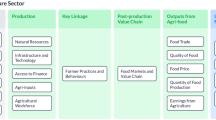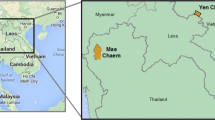Abstract
Nutrition-sensitive agriculture is a concept that aims to narrow the gap between available and accessible food and the food needed for a healthy and balanced diet for all people. It explicitly incorporates nutrition objectives into agriculture and addresses the utilization dimension of food and nutrition security, including health, education, economic, environmental and social aspects. Based on this concept, the present paper presents a synthesis of a recent desk study which took stock of innovative approaches to improve the positive nutrition-related impacts of agriculture and related food systems and provides recommendations for future programmes. By providing an overview on specific cross-cutting themes relevant to nutrition-sensitive agriculture and presenting examples from various countries on how nutrition objectives can be incorporated into the agro-food systems, the paper identifies commonalities and parameters that are entry points into a system within which local nutrition-sensitive agriculture approaches will have a realistic chance of success. The variables in the system are interlinked and contribute to a balanced nutrition of the population. By changing or fine-tuning one or more of the entry points, the whole system can be improved. The paper also highlights the current fragmentation in approaches towards more nutrition-sensitivity in agriculture and concludes that, where collaborative approaches are undertaken, there is a greater likelihood that shared projects will be implemented and/or be successful.

Similar content being viewed by others
References
Baast, E. (2013). Nutrition-sensitive agriculture in Mongolia: old paradigms and new challenges. A case study. Chapter. In D. Virchow (Ed.), Nutrition-sensitive agriculture: A pillar of improved nutrition and better health. Stuttgart: Food Security Center.
Beuchelt, T. (2013). Can nutrition-sensitive agriculture be successful without being gender-sensitive? A human rights perspective. Chapter. In D. Virchow (Ed.), Nutrition-sensitive agriculture: A pillar of improved nutrition and better health. Stuttgart: Food Security Center.
Birkenberg, A. (2013). Market integration, smallholders and nutrition: A review. Chapter. In D. Virchow (Ed.), Nutrition-sensitive agriculture: A pillar of improved nutrition and better health. Stuttgart: Food Security Center.
Burlandy, L., Rocha, C. & Maluf, R. (2010). Integrating nutrition into agricultural and rural development policies: the Brazilian experience of building an innovative food and nutrition security approach. Paper presented at the International Symposium of Food and Nutrition Security, FAO, Rome, December 7–9 2010.
CFS (2012). Coming to terms with terminology. Revised Draft 25th July 2012. Committee on World Food Security.
Christinck, A. (2013). Plant breeding for nutrition-sensitive agriculture – an appraisal of developments in plant breeding. Chapter. In D. Virchow (Ed.), Nutrition-sensitive agriculture: A pillar of improved nutrition and better health. Stuttgart: Food Security Center.
Curralero, C. B. & Santana, J. A.(2007). The Food Acquisition Program in the South and Northeast Regions. In: Vaitsman, J. & Paes-Sousa, R. (Eds.) Evaluation of MDS Policies and Programs—Results. Vol. 1, Food and Nutritional Security. Brasilia: Secretariat for Evaluation and Information Management Ministry of Social Development and the Fight against Hunger.
Dans, A., Ng, N., Varghese, C., Tai, E. S., Firestone, R., & Bonita, R. (2011). The rise of chronic non-communicable diseases in southeast Asia: time for action. The Lancet, 377(9766), 680–689.
Darith, S., & Sopheap, S. (2013). Nutrition-sensitive agriculture in Cambodia (A case study. Chapter in: Virchow, D. (Ed.) Nutrition-sensitive agriculture: A pillar of improved nutrition and better health). Stuttgart: Food Security Center.
Fan, S., & Pandya-Lorch, R. (Eds.). (2012). Reshaping Agriculture for Nutrition and Health. An IFPRI 2020 book. Washington, DC: IFPRI.
FAO. (2012a). The State of Food Insecurity in the World 2012. Economic growth is necessary but not sufficient to accelerate reduction of hunger and malnutrition. Rome: FAO.
FAO (2012b). Synthesis of Guiding Principles on Agriculture Programming for Nutrition. Draft September 2012. Food and Agriculture Organization, Rome. www.fao.org/fileadmin/user_upload/wa_workshop/docs/Synthesis_of_Ag-Nutr_Guidance_FAO_IssuePaper_Draft.pdf
Figueroa, B. M., Tottonell, P., Giller, K. E., & Ohiokpehai, O. (2009). The contribution of traditional vegetables to household food security in two communities of vihiga and migori districts, Kenya. Acta Horticulturae, 806, 57–64.
Gautam, R., Suwal, R., & Sthapit, B. R. (2009). Securing family nutrition through promotion of home gardens: underutilized production systems in Nepal. Acta Horticulturae, 806, 99–106.
Gerster-Bentaya, M. (2013). Nutrition-sensitive urban agriculture. Chapter. In D. Virchow (Ed.), Nutrition-sensitive agriculture: A pillar of improved nutrition and better health. Stuttgart: Food Security Center.
Girard, A. W., Self, J. L., McAuliffe, C., & Olude, O. (2012). The effects of household food production strategies on the health and nutrition outcomes of women and young children: a systematic review. Paediatric and Perinatal Epidemiology, 26(s1), 205–222.
Hawkes, C. & Ruel, M.T. (2012). Chapter 9 (pp. 73–81) in: Fan, S. & Pandya-Lorch, R. (eds) 2012. Reshaping Agriculture for Nutrition and Health. An IFPRI 2020 book. IFPRI. Washington, DC.
Headey, D., & Fan, S. (2010). Reflections on the Global Food Crisis. How Did It Happen? How Has It Hurt? And How Can We Prevent the Next One. Washington, DC: IFPRI.
Hotz, C., Loechl, C., de Brauw, A., Eozenou, P., Gilligan, D., Moursi, M., et al. (2012). A large-scale intervention to introduce orange sweet potato in rural Mozambique increases vitamin A intakes among children and women. British Journal of Nutrition, 108, 163–176.
Iannotti, L., Cunningham, K., & Ruel, M. (2009). Diversifying into healthy diets (Homestead food production in Bangladesh. pp. 145–151 in. Millions fed - Proven successes in agricultural development). Washington, DC: IFPRI.
IFPRI (2011). Agriculture for improved nutrition and health. A revised proposal submitted to the CGIAR Consortium Board by IFPRI on behalf of [11 further CGIAR Centres]. October 2011. www.ifpri.org/sites/default/files/crp4proposal_final_oct06_2011.pdf. Accessed 30 January 2013.
Jaenicke, H., & Azam-Ali, S. (2009). Crop diversity as a contribution to building resilience. Presentation made at the CGIAR Science Forum. The Netherlands: Wageningen.
Jeddere-Fisher, K., & Kheang, K. M. (2011). Independent mid-term evaluation of the “Joint program for children, food security and nutrition in Cambodia”. New York: MDG-F Secretariat.
Kahane, R., Hodgkin, T., Jaenicke, H., Hoogendoorn, C., Hermann, M., Keatinge, J.D.H., d’Arros Hughes, J., Padulosi, S. & Looney, N. (2013). Agrobiodiversity for food security, health and income. Agronomy for Sustainable Development Article 147. doi:10.1007/s13593-013-0147-8.
Keatinge, J. D. H., Waliyar, F., Jamnadass, R. H., Moustafa, A., Andrade, M., Drechsel, P., et al. (2010). Re-learning old lessons for the future of food – By bread alone no longer: diversifying diets with fruit and vegetables. Crop Science, 50, 51–62.
Keding, G., Schneider, K., & Jordan, I. (2013). Nutrition-sensitive agriculture as a key concept for sustainable diets: challenges in production, processing and utilisation of foods. Chapter. In D. Virchow (Ed.), Nutrition-sensitive agriculture: A pillar of improved nutrition and better health. Stuttgart: Food Security Center.
Lahiff, E., Davis, N. & Manenzhe, T. (2012). Joint ventures in agriculture: Lessons from land reform projects in South Africa. London: International Institute for Environment and Development (IIED).
Low, J., Kapinga, R., Cole, D., Loechl, C., Lynam, J. & Andrade, M. (2009). Challenge Theme Paper 3: Nutritional Impact with Orange-Fleshed Sweetpotato (OFSP). CIP Social Sciences Working Paper 2009 (1).
Maluf, R. S., Burlandy, L., Santarelli, M., Schottz, V., & Speranza, J. S. (2013). Nutrition-sensitive agriculture in Brazil. The Brazilian experience in promoting food and nutrition sovereignty and security: contributions to the debate on nutrition-sensitive agriculture. A case study. Chapter. In D. Virchow (Ed.), Nutrition-sensitive agriculture: A pillar of improved nutrition and better health. Stuttgart: Food Security Center.
Masset, E., Haddad, L., Cornelius, A., & Isaza-Castro, J. (2012). Effectiveness of agricultural interventions that aim to improve nutritional status of children: systematic review. British Medical Journal, 344, 1–7.
McLachlan, M., & Landman, A. (2013). Nutrition-sensitive agriculture in South Africa: a case study. Chapter. In D. Virchow (Ed.), Nutrition-sensitive agriculture: A pillar of improved nutrition and better health. Stuttgart: Food Security Center.
Msiska, F. B. M. (2013). Nutrition-sensitive agriculture in Malawi; a review of innovative approaches, opportunities and challenges. A case study. Chapter. In D. Virchow (Ed.), Nutrition-sensitive agriculture: A pillar of improved nutrition and better health. Stuttgart: ood Security Center.
Popkin, B. M. (2001). The nutrition transition and obesity in the developing world. Journal of Nutrition, 131(3), S871–S873.
Quisumbing, A. R. (Ed.). (2003). Household decisions, gender and development: a synthesis of recent research. DC: IFPRI. Washington.
Rahman, K. M. M., & Islam, M. A. (2013). Nutrition-sensitive agriculture in Bangladesh. A case study. Chapter. In D. Virchow (Ed.), Nutrition-sensitive agriculture: A pillar of improved nutrition and better health. Stuttgart: Food Security Center.
Reddy, K. S., & Katan, M. B. (2004). Diet, nutrition and the prevention of hypertension and cardiovascular diseases. Public Health Nutrition, 7(1A), 167–186.
Remans, R., Flynn, D. F. B., DeClerck, F., Diru, W., Fanzo, J., Gaynor, K., et al. (2010). Exploring new metrics: Nutritional diversity of cropping systems. In B. Burlingame & S. Dernini (Eds.), Sustainable diets and biodiversity. Directions and solutions for policy, research and action (pp. 134–149). Rome: FAO.
Roos, N., Wahab, M. A., Chamnan, C., & Thilsted, S. H. (2007). The role of fish in food-based strategies to combat vitamin a and mineral deficiencies in developing countries. The Journal of Nutrition, 137, 1106–1109.
Sage, C. (2012). The interconnected challenges for food security from a food regimes perspective: Energy, climate and malconsumption. Journal of Rural Studies. doi:10.1016/j.jrurstud.2012.02.005. Accessed 17 April 2012.
SUN. (2010). Scaling-up nutrition. A framework for action. First Edition.(September 2010).
Talukder, A., Haselow, N.J., Osei, A.K., Villate, E., Reario, D., Kroeun, H., SokHoing, L., Uddin, A., Dhunge, S. & Quinn, V. (2010). Homestead food production model contributes to improved household food security and nutrition status of young children and women in poor populations. Field Actions Science Reports [Online], Special Issue 1.
Termote, C., Bwama Meyi, M., Dhed’a Djailo, B., Huybregts, L., Lachat, C., Kolsteren, P. & Van Damme, P. (2012). A biodiverse rich environment does not contribute to a better diet: a case study from DR Congo. PLoS ONE doi:10.1371/journal.pone.0030533
Thompson, B. & Amoroso, L. (2011). Combating Micronutrient Deficiencies: Food-based Approaches. FAO and CABI.
Trinh, L. N., Watson, J. W., Hue, N. N., De, N. N., Minh, N. V., Chu, P., et al. (2003). Agrobiodiversity conservation and development in Vietnamese home gardens. Agriculture, Ecosystems and Environment, 97, 317–344.
UNHCHR (2010). The Right to Adequate Food. Human Rights Fact Sheet 34. Office of the United Nations High Commissioner for Human Rights. http://www.ohchr.org/Documents/Publications/FactSheet34en.pdf. Accessed 8 February 2013.
Virchow, D. (Ed.). (2013). Nutrition-sensitive agriculture: a pillar of improved nutrition and better health. Stuttgart: Food Security Center.
Weinberger, K. (2013). Home and community gardens in Southeast Asia: potential and opportunities to contribute to nutrition-sensitive food systems. Chapter. In D. Virchow (Ed.), Nutrition-sensitive agriculture: A pillar of improved nutrition and better health. Stuttgart: Food Security Center.
World Bank. (2009). Gender in agriculture sourcebook. Washington, DC: World Bank.
Yordy, C., & Laamrani, H. (2013). Nutrition-sensitive agriculture in Egypt. Household level food choices in Upper Egypt: from cereal subsidies to household gardens. A case study. Chapter. In D. Virchow (Ed.), Nutrition-sensitive agriculture: A pillar of improved nutrition and better health. Stuttgart: Food Security Center.
Zamora, O. B., de Guzman, L. E. P., Saguiguit, S. L. C., Talavera, M. T. M., & Gordoncillo, N. P. (2013). Nutrition-sensitive agriculture in the Philippines. A case study. Chapter. In D. Virchow (Ed.), Nutrition-sensitive agriculture: A pillar of improved nutrition and better health. Stuttgart: Food Security Cente.
Zezza, A., & Tasciotti, L. (2010). Urban agriculture, poverty, and food security: empirical evidence from a sample of developing countries. Food Policy, 35(4), 265–273.
Acknowledgment
The authors acknowledge the financial support of the Sector project Agricultural Policy and Food Security of Deutsche Gesellschaft für Internationale Zusammenarbeit (GIZ) GmbH for the desk study “Nutrition-sensitive agriculture: A pillar of improved nutrition and better health” and the contributions of the team of invited experts in developing the study.
The authors declare that they have no conflict of interest.
Author information
Authors and Affiliations
Corresponding author
Rights and permissions
About this article
Cite this article
Jaenicke, H., Virchow, D. Entry points into a nutrition-sensitive agriculture. Food Sec. 5, 679–692 (2013). https://doi.org/10.1007/s12571-013-0293-5
Received:
Accepted:
Published:
Issue Date:
DOI: https://doi.org/10.1007/s12571-013-0293-5




